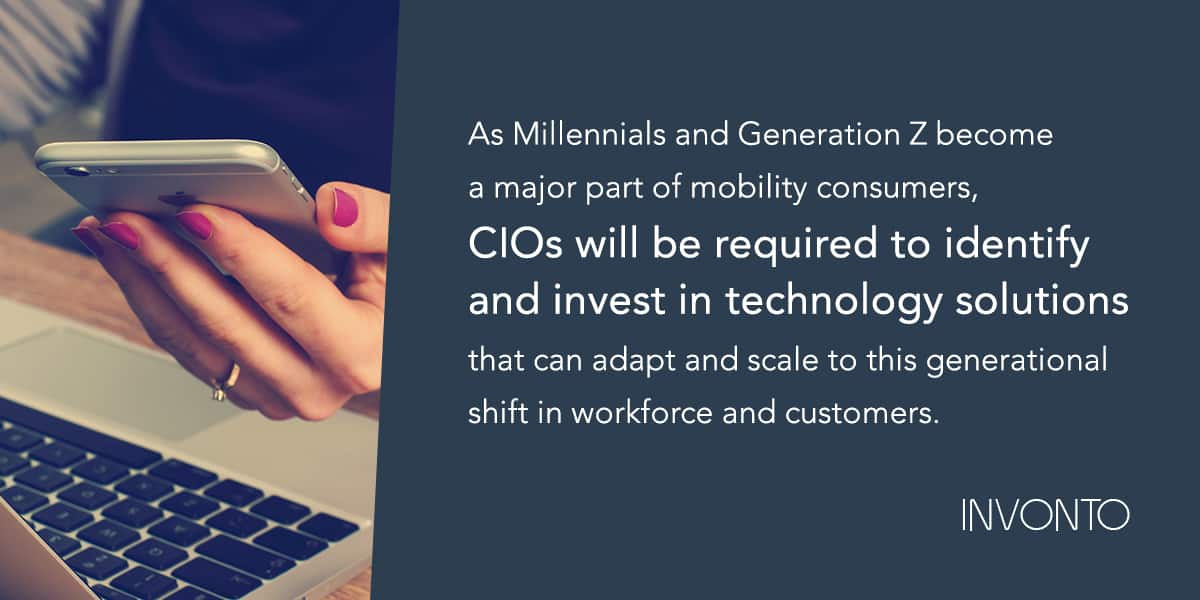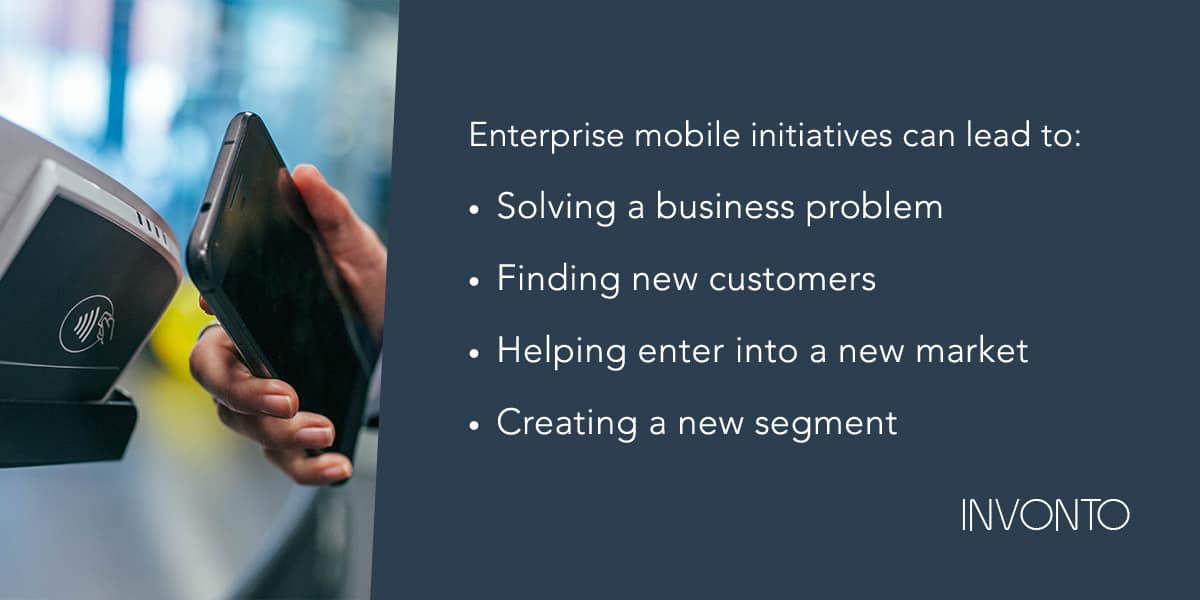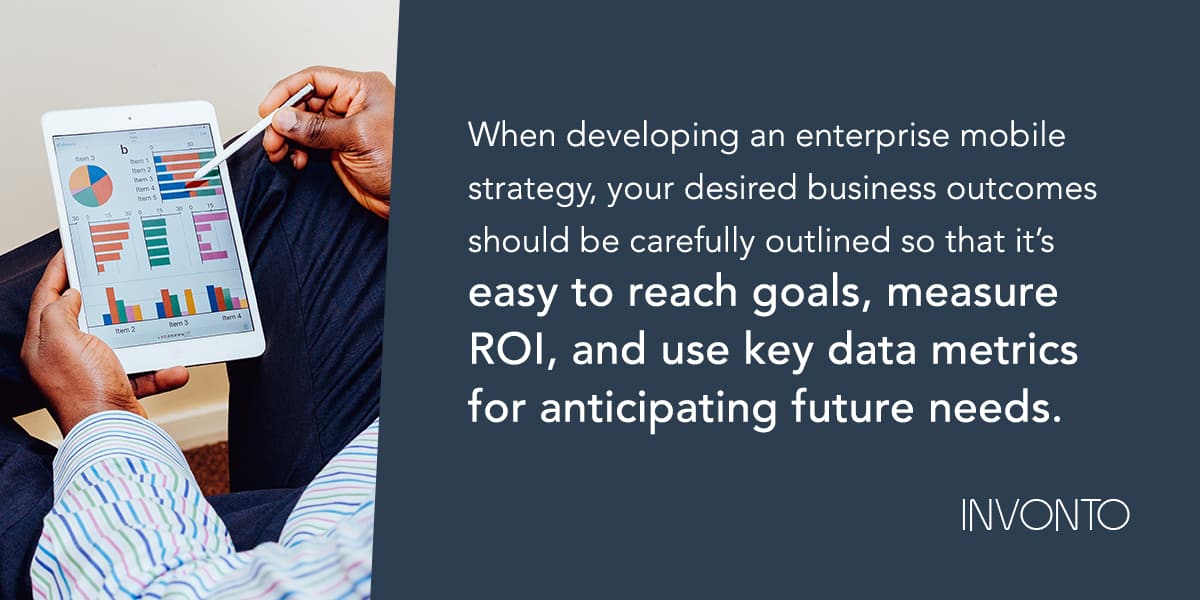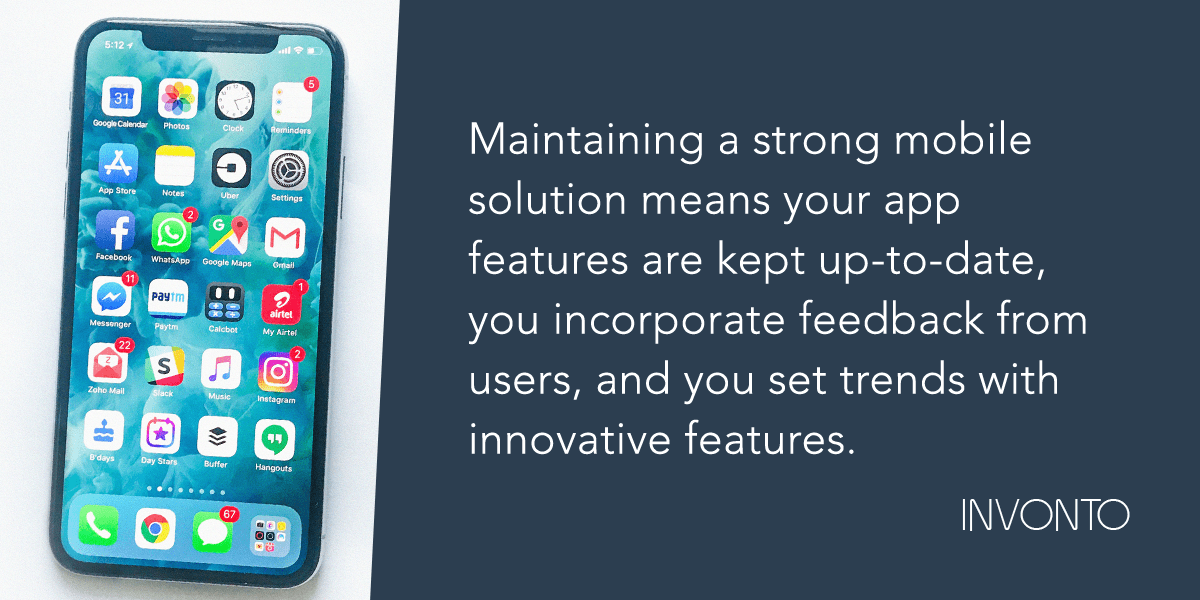Mobile Banking Apps Are Changing The Way We Bank, But That’s Just The Beginning
An effective enterprise mobility strategy is not about determining pros and cons, rather it is about embracing the overall impact that new mobile technology will have on the future of your business.
Mobile applications are a huge part of our everyday lives. In the U.S. alone, nearly half of all consumers report they spend five to six hours per day on mobile devices, not including work-related smartphone use. According to the Pew Research Center, in 2013, 31 percent of Americans, age 18 and up, say they do not use broadband at home but own smartphones. That number rose to 64 percent in 2021, making a mobility strategy critical for SMBs to Fortune 500 companies.
New technologies such as AR (augmented reality),VR (virtual reality) and AI (artificial intelligence) open up entirely new use cases for mobile applications – all of which can enable your business to achieve digital transformation.

Over the last decade, we have seen rapid advancements in mobile app development technology and network accessibility. Today’s mobile devices offer better performance and user experience. Eco-systems for apps on the Apple App Store and Google Play have grown drastically. Most major brands have invested in an enterprise mobility strategy, leading to their development and launch of increasingly sophisticated, productive mobile apps. Growing investments and advancements in mobile technology make it the preferred platform for accessing and sharing data information.
Millennials and Generation Z see mobile as the only viable platform. As they continue to join the workforce, demands for mobility solutions will continue to rise. Today, enterprise mobile app development has become a crucial part of digital strategy for all businesses.
Attentive CIOs not only recognize this shift, they are investing in technology solutions to take advantage of these changes. The long-term success of the modern enterprise depends on their ability to deliver mobile applications for their business and customers. The growing demand for mobility is already driving innovation. Companies are reinventing business operations and capitalizing on the benefits of mobile apps. That’s why today, more than 77% CIOs are considering a mobile-first approach for their digital transformation strategy. However, few businesses are prepared to create and implement their strategy, providing an opportunity for those that are to become more competitive by taking the necessary steps .
In this article, we provide you with a comprehensive guide to create an effective enterprise mobile strategy for your business.
We’ll dive into:
- Enterprise mobility trends in the 2020s
- 6 steps for creating a successful enterprise mobility strategy
- Key questions to ask during each phase
But first…
What is Enterprise Mobility?
Enterprise mobility is the deployment of mobile solutions across an organization. It leverages mobile tech to connect people, processes and data. Enterprise mobility improves how consumers interact with an enterprise’s products and services.
Highly robust enterprise mobile solutions can offer your employees numerous ways to produce a positive impact on business growth. They allow consumers to purchase and use your products and services easily. At the same time, they increase customer touch points with your business.
Enterprise mobile app development can:
Provide customers with the ability to self-provision services
Create new user experiences that are simple, personal and smart
Remove complexities from internal processes
Build new revenue systems around data
Of course, enterprise mobility strategy is ineffective in a silo. Enterprise mobility strategy is part of an overall tech narrative of an organization leading to digital transformation. An enterprise mobility strategy takes into account the entire range of digital initiatives within your business.
“Developing a successful enterprise mobility strategy is no longer just ahead-of-the-curve thinking. Enterprise mobility is a must for any company seeking to stay competitive.”
Benefits of enterprise mobility solutions
An effective enterprise mobile strategy can benefit your customers, business, employees, vendors and partners.
Improve Security
Mobile devices are now a necessity. Your employees will use their own devices for work if they aren’t equipped with a company-owned device. That can lead to costly data security breaches, the smallest of which can cost millions. An enterprise mobility strategy that takes company-owned and employee-owned devices into account can address potential security risks, helping to safeguard your employees, your customers, your company as well as your data.
Increase Productivity
Employees that can access their work from anywhere through enterprise mobile apps can be more versatile, efficient and productive. Employees gain the ability to work offsite, from home or during their commute. Studies show that enterprise mobility solutions can improve productivity by 23%.
Reduce Costs
Employees tend to be more comfortable using their own devices. Companies that have a BYOD (bring your own device) policy can save money if they implement an enterprise mobile strategy that includes securing employee devices. When done correctly, businesses can greatly reduce overall spending through a comprehensive enterprise mobility solution.
Make Informed Decisions Faster
Data accessibility becomes critical when employee decisions impact the business. Real-time access to data can make employees more efficient and productive and increase the accuracy of their judgment. Field service employees can quickly communicate with employees in the office. Businesses can run meetings regardless of whether everyone is physically present. Work progress can be reviewed from anywhere. With an enterprise mobility solution, your team can make informed decisions faster.
Be Prepared
An enterprise mobility solution can help you withstand natural disasters, which can present risks to any business. Such a solution could prevent the disastrous loss of documents and locally-stored data, empowering your business to continue to operate uninterrupted.
Improve Employee Retention
When work is simpler, employees are happier. An enterprise mobility solution can simplify processes, enabling your staff to focus on tasks and improve productivity with less stress. These changes can result in better work-life balance and build a strong company culture. This can lead to an increase in employee satisfaction and retention.
Foster a Culture of Innovation
Enterprise mobile applications enable companies to experiment with modern digital technologies like augmented reality, artificial intelligence, and the internet of things. This can lead to finding innovative ways to improve business processes, engage customers, and develop new products. A culture of innovation can help companies with their digital transformation and become industry leaders.
Recent Trends
Enterprise mobility solutions vary widely by industry. However, every business must have an enterprise mobility strategy that is:
- Unique to its own industry
- Addressing its specific business needs
- Based on its current stage of mobile adoption
Below are some examples of mobility solutions that have disrupted several industries:
FinTech
Mobile payment solutions are advancing quickly. They offer consumers easier ways to pay with their mobile device. In 2019, just 29 percent of smartphone owners in the U.S. made proximity mobile payments. Such transactions occur when the payer uses a mobile device in the same location as the payee. In 2021, just two years later, 43.2 percent of smartphone owners in the U.S. made proximity mobile payments. This trend will likely increase, providing tremendous opportunities for growth in FinTech, including:
- Mobile banking services
- Mobile wallets with enhanced security
- Mobile commerce applications
- Mobile real-time investing
- Mobile payment solutions
Construction
Mobile is transforming the real estate and construction industries. For example, augmented reality for mobile devices allows anyone to visualize a space. Builders can overlay BIM models on the construction site. Architects can present architectural models in 3D. Home buyers can “walk” into their new home miles away without leaving their living room.
Cost and pressure on the industry will drive the adoption of augmented reality across all phases of the construction process. Home builders and construction companies will embrace mobile technologies for:
- Field service solutions with access to actionable data in real time
- Customer, builder, and vendor collaboration solutions
- Optimizing and mobilizing business processes
- Product visualization
Retail
Mobile apps are capable of providing a richer in-store customer experience. Consumers can receive notifications about sales as they walk through store aisles. Regular customers can enjoy the benefits of a loyalty program. Early adopters in the retail industry are taking full advantage of mobile technology. With custom mobile apps, retailers can differentiate their products and services.
A perfect example of this concept is the Target mobile app. Users can access the Target app to locate products at their preferred store. Shoppers can also use the app to plan grocery lists in advance and purchase items for pick-up. Users can also scan in-store items for additional savings and rewards.
Retailers can add value by personalizing mobile experiences. They can seamlessly integrate voice & AI functions with digital assistants. In addition, brands can differentiate on more than just price. Rather, brands can focus on redefining the customer experience.
Emerging technology can also make retail apps more powerful when the shopper is not in the store. For instance, augmented reality enables customers to “virtually” try on products in their home before purchasing.
Logistics
Real-time logistics management technology offers so many advantages that it has disrupted traditional freight, logistics and supply chain operations. This technology gives businesses access to actionable data tor:
- Optimize lead time schedules
- Manage the supply chain
- Streamline processes for error reductions and operational efficiencies
- Utilize geospatial data from transportation networks
- Improve inventory turns
- Reduce inventory holding costs
Enterprise mobility solutions are moving the supply chain with apps for fleet tracking, inventory management, and order fulfillment. In logistics, the advantages of working smarter with mobile apps are apparent.
Healthcare
Mobile telehealth and telemedicine applications provide real value to patients and clinicians. Healthcare providers can offer remote digital healthcare services, delivering convenience, choice, personalization and control to patients.
According to an American Medical Association (AMA) survey, nearly 85% of physician respondents are currently using telehealth to care for patients, and nearly 70% report their organization is motivated to continue using telehealth in their practice. This includes providing telehealth services for managing chronic disease, ongoing medical treatment, care coordination, mental and behavioral health and specialty care.
As more patients and healthcare providers become accustomed to remote medical care services, opportunities in the sector will grow. Several other technologies making strides can help make healthcare more accessible. They include augmented reality, voice, artificial intelligence, and machine learning.
As of the first quarter of 2022, health and fitness apps make up less than five percent of the available apps on the Apple App Store. And while major brands Nike and Adidas have invested heavily in fitness apps, the apps that lead in revenue for 2020 and 2021 can be described more as startups in the tech space. These include MyFitnessPal, Strava and Fitbit. This demonstrates that the top apps have the best ideas and provide the best user experience, and not necessarily name recognition, and that there’s room to enter this sector.
Key Steps for Your Enterprise Mobility Strategy
An enterprise mobility strategy is a part of your digital transformation strategy. Drafting a strategy for any organization can be overwhelming. However, if done right, your enterprise mobility strategy can scale business growth. As a guiding document, it can help you evolve with the changing tech landscape and growing business needs.
“Your overarching mobility strategy goal should be to improve business operations for both your customers and employees.”
An enterprise mobility strategy can:
- Increase market share
- Improve staff productivity
- Reduce operational costs
- Provide real time access to data
- Enable multi-channel collaboration
- Identify the unique selling proposition (USP)
- Level the competitive landscape
There are six steps to create any successful enterprise mobility strategy.
1. Define Your Business Needs
Enterprise mobile solutions can help solve your business problems, find new customers, and create innovative digital products to grow your business. To start, first establish your business needs. Work toward understanding your company’s strategic goals. Use key performance indicators (KPIs), customer feedback and industry trends to define your business needs.

You may ask yourself:
- What are the enterprise mobility trends in your industry?
- What are your business’s core products and services?
- Where do you see your business in the next 3, 5, and 10 years?
- Where are the bottlenecks in your business?
- Who are your customers?
- Are you meeting their needs?
- Who needs access to your data? Do you need different levels of access?
- How will you handle data privacy for your organization?
An enterprise mobility strategy does not replace your overall digital strategy. Mobile apps can help but will not solve all your business problems. Mobile apps do not replace your other technology initiatives. Enterprise mobility solutions are part of your overall digital goals. That is why your identifying business needs is crucial to the success of your enterprise mobile strategy.
“Oftentimes your employees and your customers will experience the same challenge from different perspectives.”
Let’s use a popular restaurant chain as an example. This chain wants to integrate geo-tracking into their mobile app to accomplish several business goals related to delivery.
Business goals
The business wants to reduce the amount of calls received about customer deliveries. It distracts employees from other tasks and negatively affects the brand. Geo-tracking enables employees to spend less time fielding customer calls about deliveries and helps the business see the driver’s location in real-time. This keeps the drivers accountable while on the clock.
Employee goals
The employees don’t want to take phone calls from unhappy customers about their delivery. The driver wants to know the fastest route from the restaurant to the customer, enabling them to make more deliveries and more money.
Customer goals
The customer just wants to know when they’ll get their food. Geo-tracking lets customers see in real time where the driver is and when their delivery is expected to arrive. They become happier and more satisfied, are far less likely to call the restaurant about their order, and far more likely to order again in the future.
Identifying business goals will lead to defining business solutions. The example above is the reason why Uber Eats and DoorDash are so popular. The businesses identified a customer need and developed apps that can be used by restaurants and consumers.
Here are a few more questions to help you further:
- How does your client buy or receive your product or service?
- When in the buying process do customers interact with employees?
- How do customers interact with employees?
- How can you improve customer experience?
- Which solutions help increase customer touch points?
- How can a mobile solution address employee experience and efficiency?
2. Perform Competitive Research
Now that you have identified your goals, it is time to research competitors.
Select a minimum of three competitors to analyze. Choose competitors based on your business objectives and industry trends. When selecting competitors, choosing a mix of top companies and innovative startups in your sector can enable you to cover all bases.
“If your competitor is a new player in the industry, understand how they may be offering mobility solutions that lead to industry disruption.”
First question:
What enterprise mobility solutions have your competitors built for their employees and customers?
Search competitor websites and online mentions. If they have applications, you can learn more about them on the app store. You can also download their app and try it. Even if you only have access to conceptual information it may be enough to piece together the “what” and “why.”
Furthermore, try to research their timeline and budget. Websites like Crunchbase offer details into how much companies invest into their business and technology initiatives. Companies also discuss some of this in their press releases and media interviews. This can help you budget appropriately for creating similar, competing mobile apps.
Once you identify mobile solutions based on your competitive research, answer these questions to fine tune your enterprise mobility strategy:
- Will this app solve any business problems or create value?
- How will you address feedback app users have provided for the competitors apps?
- What impact will new mobile apps have on your business processes?
- Does your business have the necessary technology infrastructure to build and support a mobile app?
- How are your competitors marketing their apps?
Next, create a competitor analysis spreadsheet and document your research. This will help as you move to the next phases of your mobility strategy.
In some cases, none of your competitors may have an app, providing a tremendous opportunity for your business to become an industry leader.
3. Set Strategic Goals and Objectives
The first two steps in our strategy guide can help you identify your needs. Next, we want to prioritize your needs with goals and objectives.
Important questions to ask:
- Which apps will have the most impact on your business, employees, and users?
- Is your business ready to support this app?
- Is mobility the right channel to deliver the solutions your business needs?
Your long-term implementation objectives relate to usage and scalability. In addition to the day-to-day usage, you’ll be gathering endless amounts of data.
Consider these additional questions:
- What new opportunities will your mobile app solution create? (Step 1 can help you here)
- How will you determine your return on investment (ROI)?
- How can your business benefit from the collected data?
- How will you scale your app as your business needs grow?
- How will you support and maintain your apps?

The time you take to clarify your goals and objectives will make it easier to measure key metrics for future success.
4. Choose the Right Mobile Experience and Platform
Developing a mobile app is not the same as developing a web application. While it’s common to think of it as a screen size adjustment, it’s not the case. In fact, more work goes into creating a mobile app than creating a website with the same features. There are two popular mobile platforms: iOS from Apple and Android from Google. These mobile platforms require developing apps using their unique development environment. A mobile app’s functions are custom-designed for each mobile platform. This provides app users with unique user experience specific to their mobile devices.
Native Mobile Apps
Native mobile apps are built specifically for iOS or Android. Users must download them from the appropriate app store to a mobile phone or tablet. Native mobile apps make the most of a mobile device’s firmware and hardware, allowing them to take full advantage of the device’s capabilities. Native mobile apps perform well and deliver the best user experience. Most companies prefer developing native mobile apps.
For your initial launch, we recommend creating either an iOS app or Android app based on your target audience. By choosing one platform, you will shorten the delivery timeline, reduce investment and have an opportunity to perfect the app. You can then use everything you and your team learned on the first mobile platform, making it easier to build mobile app for other platform.
Mobile Web Apps
Mobile web apps are technically websites accessed from a browser like safari and chrome on mobile devices. These types of apps are responsive and can look like a mobile app, and work across all iOS and Android devices. This capability reduces initial investment and timeline for creating mobile web apps. Users can even add a launch icon to their mobile device, making access to them similar to native apps.
The downside is that mobile web apps get limited access to a mobile device’s hardware capabilities. The upside is that companies with existing enterprise web applications will find mobile web apps as an inexpensive, rapid way to launch new enterprise mobility solutions.
Below, see a comparison of both approaches.
| Native Mobile App | Mobile Web App | |
|---|---|---|
| App Development Process | If you need your app to be available on iOS and Android mobile platforms, you will have to develop native mobile apps for each one. You will also have to customize each app for supporting different device types (phone, tablets and phablets). | A mobile web app is essentially a web site that is accessible from a browser on the mobile device. By using responsive design, existing and new web apps can be made mobile-friendly. Mobile web apps works across all mobile platforms and device types. |
| Skill Requirements | Since each mobile platform uses its own technology stack, you might need multiple developers with development skills specific to each mobile platform. | Your web development team will build and support your mobile web apps, so you will not have to invest into new development resources. |
| Infrastructure | With native mobile apps, you may have to make additional investment into procuring mobile devices, mobile device management solutions—and figure out governance policy. | Your users can continue to use their own mobile devices. And, even if you are providing them with mobile devices, you can keep all users on the same mobile platform. |
| Accessibility | Native mobiles apps will have full access to device firmware and native functionality, providing endless capabilities to the app developers. | Mobile web apps will not be able to access some of the device functions such as push notifications. |
| Network Dependency | Native mobile apps can have offline working capability, which can be beneficial if users are often working from areas with little to no internet connectivity. Native apps can detect network connectivity and sync with the server back-end when connection resumes. | Mobile web apps require internet connectivity for accessing website features. |
| Performance & User Experience | With a native mobile app, you can customize and personalize user experience specific to each mobile platform. Native apps can run faster and more efficiently—making the most of capabilities of a mobile OS and device hardware. | Mobile web will have the same user experience across all mobile platforms and device types. This often becomes a limitation, since users expect app user experience customized to their mobile platform. Speed and performance of mobile web apps will be somewhat dependent on network bandwidth and device functionality that the app is dependent on. |
| App Support & Maintenance | You may have to update your app with the release of a new version of mobile OS or mobile devices. | Mobile web apps do not get affected as much by advances in mobile technology. Therefore, you do not have to update your app as frequently. |
Hybrid Apps / Cross Platform Apps
Cross-platform mobile apps use frameworks such as React Native and Flutter. These apps have a common codebase and can run across all mobile platforms. Hybrid apps use web technologies like Javascript and HTML5. These apps run within a native app container. Its name comes from the dual structure of the app being part web and part mobile. Like cross-platform mobile apps, hybrid apps also run across all mobile platforms.
The reason we don’t recommend hybrid and cross-platform apps is because they do not perform as well as native apps. Savings in initial mobile app development costs will be limited to 10-15 percent. However, these apps require more effort to scale and maintain because they are not as widely supported as native apps. Most companies prefer to build native mobile apps or mobile web apps.
Choosing the right mobile platform is essential to the success of your enterprise mobility strategy. Once you make this decision, it can be difficult and costly to reverse it.
These questions will guide you in the right direction:
- Who are the primary end users of your enterprise mobility solution?
- What devices will be used?
- For enterprise mobile apps, will you provide mobile devices for your employees or will you have a BYOD (bring your own device) policy?
- What mobile platform will your app support: iOS, Android, or both?
- What device type will your app support: smartphone, tablet, or both?
- How will users interact with your applications?
- Will your mobile app need access to a device feature like camera, speaker, GPS, accelerometer, or bluetooth?
- Will your mobile app require AR technology for features like product try-on, employee training?
- Will your mobile app include image recognition or data personalization through machine learning?
- Will your digital transformation roadmap also include web applications?
Sometimes, the discovery phase will require you to separate app requirements across multiple solutions. The end result is a suite of applications each serving a particular function. For example, Microsoft has the Office suite including Microsoft Word, Excel and Powerpoint. Adobe has a large suite of design software including Photoshop, Illustrator and Indesign. If you are finding it difficult to include every feature in your app, consider building a family of apps that do specific things really well rather than releasing an app that’s complicated to use.
5. Create a Plan for Continuous Delivery
There is fierce competition for market share between iOS and Android. Companies like Google, Samsung and Apple are rapidly advancing mobile technology. Every year, we see new versions of mobile devices and platforms. Because the landscape changes so quickly, agility is crucial to a successful mobility strategy. Alongside your long-term plan, consider short-term requirements. In mobile app development, continuous support to address bugs, new features and security vulnerabilities is just part of the process.
Does your brand already have preexisting app development and deployment methodologies? If so, they may need to be revamped to keep pace with continuous delivery for new mobile applications. If you do not have established development processes then our article Mobile App Development Process: A Step by Step Guide can offer you guidance.

Another aspect to remember is that data-driven mobile apps rely on APIs (application programming interfaces). APIs are used to communicate with the server back-end and databases. A strong API infrastructure will aid in the scalability, interoperability and maintainability of your mobile apps. Your continuous delivery plan should support the server back-end and database changes.
These questions will help you create your agile development plan:
- What apps and features will be of most value to users?
- Can you prioritize your app features in high, medium, and low categories?
- What new services will your business be introducing in the coming years?
- How frequently can your team release updates for your mobile apps?
- Can you ensure continuous delivery on the back-end to support your app?
Some of these questions may be difficult to answer. Please let Invonto know if you’d like to speak with us about your app.
6. Outline a Security Strategy and Incorporate Governance Policy
An app can help your company improve how customers interact with your business as well as how your employees do their jobs. But an unstable or unsecure app can do damage.
Your governance policy should address:
- The development processes
- Device provisioning
- Data access and security
- Interruption coverage / disaster recovery
- Mobile application management
- Ongoing infrastructure improvement needs
Larger organizations may need to establish a governance team. This team will have members representing each department affected by mobility solutions. The following questions will help you establish an effective governance policy:
- Who are the different stakeholders and personnel involved with your mobile initiatives?
- What device policy will you need? For instance BYOD, CYOD (choose your own device), or COPE (corporate-owned, personally-enabled)
- How will you secure your APIs?
- What security solution will you use to ensure data security?
- How will your app users be authenticated (SSO, OAuth, OpenID, Fingerprint, Facial Recognition, 3rd party credentials)?
- What development and deployment process will you follow?
- Will your apps have role-based access? Do you have the required identity management systems in place?
- What parameters will your app testing cover? For example usability, functionality, performance, security
- How should your app users be notified of new releases?
- What industry-specific compliance measures do you have to consider?
- How will your customer service and product tech team interact with users for product support?
- What steps do you need to take in the event of a service interruption?
Consistency across your business in enforcing the mobility governance policy and enabling IT to be proactive will help protect your company, your customers and employees as well as related data.
Other Considerations for Success
Developing your enterprise mobility strategy is a long, but rewarding process. Many of our clients have relied on us to develop their enterprise mobility strategy. That experience has led to our development of the following takeaways:
Device Flexibility
You might consider incorporating a BYOD policy. If you do, understand that your employees will all have different devices. Your enterprise mobility strategy will need to account for this.
Embrace New Opportunities
It is easy to dismiss new ideas. Instead, we encourage you to evaluate every potential solution for its opportunity to provide innovation. A little bit of research on each idea can result in significant savings and benefits.
Estimate Each Initiative
A key criteria for success is delivering your mobile apps on time and within budget. To do this, find out how long does it take to make an app and how much does it cost to make an app. We’ve also created an app cost calculator that can help you get ballpark estimates for any app idea within five minutes. Such estimates will help you plan and fund your mobile initiatives.
One Size Does Not Fit All
Your enterprise mobility strategy should account for all departments in your organization. A company with multiple departments will have different needs. Identify primary users, both internal and external, for your mobile apps. If the needs of each group vary too much, you may need to build different solutions.
Secure, Scalable, Supportable
Every app you build should account for the app’s security, scalability and support. If the app cannot achieve this, it will be difficult to maintain them in the future.
Focus on Short-Term Goals
Planning a long-term strategy ensures a successful implementation. However, short-term goals help you track progress toward long-term goals. Goal tracking also keeps your team motivated as they achieve each milestone.
Hire The Right Team
If you haven’t dealt with mobile applications before then creating mobile apps is likely to be a major undertaking. You might not have the mobile UI designers and app developers on your team as mobile app development is not the core of your business. This is why many companies hire app development agencies for their app development.
Conclusion
A successful enterprise mobility strategy needs sufficient planning and coordination within your business. However, the outcome can be a cornerstone of your company’s digital transformation journey.
To review, prepare a mobile strategy that’s right for your business in 6 steps:
- Define your business needs
- Conduct research and perform competitive analysis
- Set strategic goals and objectives
- Choose the right mobile experience and platform
- Create a plan for continuous delivery
- Outline a security strategy and incorporate governance policy
Enterprise mobile solutions can deliver significant ROI for your business:
- Increase market share
- Improve staff productivity
- Reduce operational costs
- Provide real time accessibility to data
- Enable multi-channel collaboration
- Identify your unique selling proposition (USP)
- Increase your competitiveness
What goals do you want to achieve with your enterprise mobility strategy? Do you need help to create your enterprise mobility strategy? Contact our experienced mobile app development team today to schedule your consultation.



